November 23, 2013
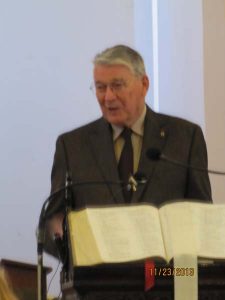 Our speaker was retired Brigadier-General William Patterson, Chair of the Lower Burial Ground Restoration Society, presented a most informative history of the cemetery around St. Paul’s. The society was created in 2007 after individuals became aware of the deterioration of the west wall of the burial ground and the Forsyte monument. They incorporated the society as a charity, raised funds, and began to do both research and repair work. In 2012 they also paid for restoration of the Stuart Family monument. It is planned to continue restoration work over the next fifteen years or so, with the Cartwright monument being the goal for 2014.
Our speaker was retired Brigadier-General William Patterson, Chair of the Lower Burial Ground Restoration Society, presented a most informative history of the cemetery around St. Paul’s. The society was created in 2007 after individuals became aware of the deterioration of the west wall of the burial ground and the Forsyte monument. They incorporated the society as a charity, raised funds, and began to do both research and repair work. In 2012 they also paid for restoration of the Stuart Family monument. It is planned to continue restoration work over the next fifteen years or so, with the Cartwright monument being the goal for 2014.
Unlike the usual procedure, where a graveyard grows around an existing church, St. Paul’s was built in an existing cemetery. In 1825 a group petitioned the Upper Canada government for a patent for the Lower Burying Ground. With their petition, they included sworn affidavits from four Loyalists to prove that burials had taken place there since 1783, and that they had always been conducted by Anglican chaplains and never by a Presbyterian minister. (The Presbyterians had no place to bury their dead, as the newer Upper Burial Ground had been divided between the Roman Catholics and Anglicans.)
The four Loyalists were:
- John Ferguson, husband of Molly Brant’s daughter Magdalena who said an army Corporal was buried here in 1783
- Thomas Marker, Colonel of Militia, who reported attending a burial here by Rev. John Stuart
- William Crawford, Ensign in the 2nd Battalion up to 1784 who recalled people dying and being buried here
- John Carscallen, Sergeant in the 2nd Battalion, who said that as deputy chaplain he read the burial service over Corporal Forbes, the first burial.
In light of these affidavits, the government granted a land patent to St. George’s Church for the Lower Burial Ground.
As the population grew, there was need for more Anglican churches. St. Mark’s (Barriefield) opened in 1843, St. James in 1844. And in 1845, St. Paul’s was erected within the graveyard. It is unknown just how many graves were disturbed or covered by construction of the church building. The first building burned in 1855 and was rebuilt in 1856. The church hall was erected in 1872, and more graves may have been disturbed. The Lower Burial Ground is the oldest consecrated cemetery in Ontario, with burials between 1783 to 1863.
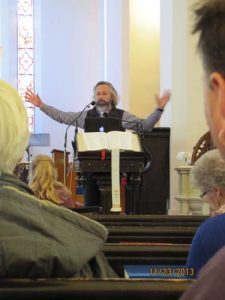 Professor Alex Gabov, from the Department of Art Conservation at Queen’s University, then spoke about his project to use Reflectance Transformation Imaging in order to read the inscriptions on the stones in the churchyard. Even stones which are so weathered that it appears there is no inscription can be made greatly more readable. Unfortunately some technical problems prevented him fully demonstrating this to us, but the RTI blog he shares with Professor George Bevan gives a good idea of the type of work they and their students will be able to do. This page will show you examples of stones from Cataraqui Cemetery that were read using RTI.
Professor Alex Gabov, from the Department of Art Conservation at Queen’s University, then spoke about his project to use Reflectance Transformation Imaging in order to read the inscriptions on the stones in the churchyard. Even stones which are so weathered that it appears there is no inscription can be made greatly more readable. Unfortunately some technical problems prevented him fully demonstrating this to us, but the RTI blog he shares with Professor George Bevan gives a good idea of the type of work they and their students will be able to do. This page will show you examples of stones from Cataraqui Cemetery that were read using RTI.
March 23, 2013
After a sandwich and squares lunch, we held a brief business meeting and then heard from a number of members who had items and stories to “Show and Tell”.
First was Nancy Cutway, who spoke about two books she has found helpful doing Loyalist genealogy. The first contains Muster counts taken every 2 to 3 months to report on who was in a regiment to allow the man to be paid. Loyalists in the Southern Campaign of the Revolutionary War is a 3-volume set by Murtie June Clark. The Southern campaign includes most actions that occurred anywhere south of New York state, down to the final battles at Yorktown, Virginia so many folks are in these books. You can follow your Loyalist over several years, and see when he was noted to be sick, a prisoner, or other notes about him. Most of the muster lists are held in Library and Archives Canada.
For the benefit of our distant members, you don’t need access to our Branch library to find this book, although we’d certainly welcome you to visit Kingston. If you have access to Ancestry.ca through either a personal subscription or your local library’s or Family History Centre’s subscription, you can find all three volumes of Loyalists in the Southern Campaign digitized at Ancestry. You will need to search each volume separately.
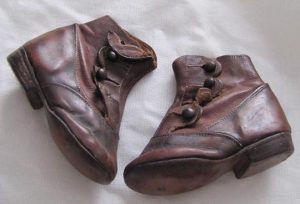 Second, Nancy mentioned Irish Palatines in Ontario, by Carolyn A. Heald. The Revised Edition (2009) is still available at Global Genealogy.com. Palatines were Protestant refugees from Germany who fled to England and appealed to Queen Anne for asylum. Many were sent on immediately to the American colonies, but a large number were relocated to Ireland by the English, who wanted to increase the number of Protestants in Ireland. A large proportion of the Palatines remained in Ireland for only about one generation, and went to New York around 1760s. Nancy reported on the Dulmage family, part of this Palatine-Loyalist group who travelled and settled together. Her UE ancestor David Dulmage settled in Marysburgh, Prince Edward County. Nancy showed the tiny button shoes of David’s great-great-grand-daughter Hazel Dulmage who was born 1892.
Second, Nancy mentioned Irish Palatines in Ontario, by Carolyn A. Heald. The Revised Edition (2009) is still available at Global Genealogy.com. Palatines were Protestant refugees from Germany who fled to England and appealed to Queen Anne for asylum. Many were sent on immediately to the American colonies, but a large number were relocated to Ireland by the English, who wanted to increase the number of Protestants in Ireland. A large proportion of the Palatines remained in Ireland for only about one generation, and went to New York around 1760s. Nancy reported on the Dulmage family, part of this Palatine-Loyalist group who travelled and settled together. Her UE ancestor David Dulmage settled in Marysburgh, Prince Edward County. Nancy showed the tiny button shoes of David’s great-great-grand-daughter Hazel Dulmage who was born 1892.
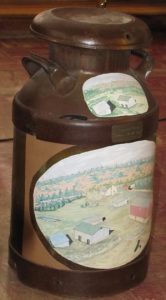 Jim Long brought a milk can, painted by his maternal grandmother. It shows Longdell Farm, the family home near Arden, Ontario. The farm included a cranberry bog and sugar bush. Jim spoke of the value of connecting with other genealogists: a researcher from Ryde Township (east of Gravenhurst) found him through the UELAC website and wanted to discuss the Long family because, as it turned out, one of Jim’s ancestors lived and is buried there. He mentioned several Loyalist families and their predecessors, which he and Ms. Fraser are now researching together.
Jim Long brought a milk can, painted by his maternal grandmother. It shows Longdell Farm, the family home near Arden, Ontario. The farm included a cranberry bog and sugar bush. Jim spoke of the value of connecting with other genealogists: a researcher from Ryde Township (east of Gravenhurst) found him through the UELAC website and wanted to discuss the Long family because, as it turned out, one of Jim’s ancestors lived and is buried there. He mentioned several Loyalist families and their predecessors, which he and Ms. Fraser are now researching together.
Eva Wirth showed Canadian postage stamps that commemorated the Loyalists. A 1934 stamp, issued to commemorate the 150th anniversary of the arrival of the Loyalists, shows the UEL monument in Hamilton, Ontario that. A second stamp was issued in 1984 to commemorate the 200th anniversary. Images of these stamps as well as some commemorating individuals of Loyalist descent can be found at the UELAC website.
Doug and Marianne Thompson brought a display giving a progress report on the work of the Lower Burial Ground Restoration Society. The cemetery outside St. Paul’s Anglican Church, where we meet, is the oldest in Kingston. Time and weather have not been kind, but over the past three years the Society has overseen the restoration of the exterior wall, the Forsyth family monument, and the Stuart family enclosure. Work remains to be done on restoring gravestones, some of which are in numerous pieces presently stored in the church basement. Tax-deductible donations are always welcome.
John Chard prepared a handout of information about Loyalists, which he encouraged all present to share with family members, particularly grandchildren and youths, so they become more aware of the place of the United Empire Loyalists in the founding of Canada. John kindly granted permission for this information to be shared with all, and the documents are now on our Resources page.
John Lynn Bell displayed his groupings of old photos on similar topics: men with beards, women with bonnets, etc. He also collects old licence plates, and showed a 1911 Ontario licence plate which was one of the few ceramic plates ever made.

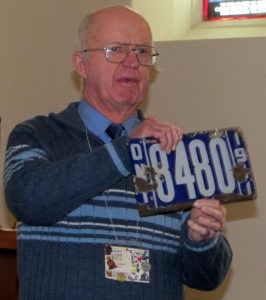
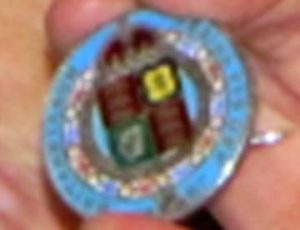 Sue Kilpatrick, a new member, brought a pin made from a British sovereign coin. On the back is the image of Queen Victoria that would have been on the silver coin; someone has enameled the front and painted the outer ring that would be on the crest of the Order of the Garter, although the interior of the crest varies from the official design. It makes a curious and interesting brooch.
Sue Kilpatrick, a new member, brought a pin made from a British sovereign coin. On the back is the image of Queen Victoria that would have been on the silver coin; someone has enameled the front and painted the outer ring that would be on the crest of the Order of the Garter, although the interior of the crest varies from the official design. It makes a curious and interesting brooch.
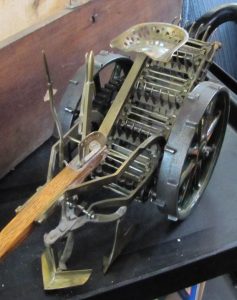 Peter Davy brought a model of Davy’s Potato and Turnip Extractor, patented 1874. This likely was the model his relative had to submit with his application for the patent. It was meant to automate the digging of root vegetables: a shovel foot either side of the device dug into the soil, the geared wheel rotated it upward, and the vegetables would fall into a bin carried on the back of the extractor. This intricate model was found in a cupboard over a doorway when Peter and Carol moved back into the old family farmhouse built by Peter’s great-grandfather in 1849, and started renovating. The patent for it was #2638, granted to John Wesley Davy on August 13, 1873 – see the patent applicationwhich was found at the Library and Archives Canada searchable database of patents between 1869 and 1919. Some present thought this might have been a salesman’s model instead, particularly since it has the date 1874 on the back end. Whatever the purpose, it is an intricate and interesting model. It’s also a mystery how it made its way from Georgetown, Ontario where J.W. Davy was living, back to his ancestral home.
Peter Davy brought a model of Davy’s Potato and Turnip Extractor, patented 1874. This likely was the model his relative had to submit with his application for the patent. It was meant to automate the digging of root vegetables: a shovel foot either side of the device dug into the soil, the geared wheel rotated it upward, and the vegetables would fall into a bin carried on the back of the extractor. This intricate model was found in a cupboard over a doorway when Peter and Carol moved back into the old family farmhouse built by Peter’s great-grandfather in 1849, and started renovating. The patent for it was #2638, granted to John Wesley Davy on August 13, 1873 – see the patent applicationwhich was found at the Library and Archives Canada searchable database of patents between 1869 and 1919. Some present thought this might have been a salesman’s model instead, particularly since it has the date 1874 on the back end. Whatever the purpose, it is an intricate and interesting model. It’s also a mystery how it made its way from Georgetown, Ontario where J.W. Davy was living, back to his ancestral home.
 Anne Redish brought a two-piece dress that belonged to her 3-greats-grandmother. It’s entirely of wool. The underdress is quite shapeless with a V-neck top, and Anne wonders if it was designed for a nursing mother. The jacket would provide instant modesty when added over the dress. Anne hopes to make a pattern from it and use it for a 19th-century costume she is designing. Anne also brought an early box for Laura Secord candies — she pointed out that the company first used the actual image of Laura Secord, before adopting a more “artistic” image.
Anne Redish brought a two-piece dress that belonged to her 3-greats-grandmother. It’s entirely of wool. The underdress is quite shapeless with a V-neck top, and Anne wonders if it was designed for a nursing mother. The jacket would provide instant modesty when added over the dress. Anne hopes to make a pattern from it and use it for a 19th-century costume she is designing. Anne also brought an early box for Laura Secord candies — she pointed out that the company first used the actual image of Laura Secord, before adopting a more “artistic” image.
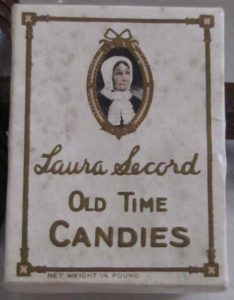 Anne also mentioned books that members might enjoy reading. As a follow-on from our January 2013 meeting, you might want to reading The embroidered tent: Five gentlewomen in early Canada by Marian Fowler (Anansi Press, 1994) and Mrs. Simcoe’s Diary edited by Mary Quayle Innis (1983). As a tribute to our late member Earle Thomas, you could read one of his books: Greener Pastures: The Loyalist experience of Benjamin Ingraham (Mika Publishing, 1983) or The Three Faces of Molly Brant (Quarry Press, 1999).
Anne also mentioned books that members might enjoy reading. As a follow-on from our January 2013 meeting, you might want to reading The embroidered tent: Five gentlewomen in early Canada by Marian Fowler (Anansi Press, 1994) and Mrs. Simcoe’s Diary edited by Mary Quayle Innis (1983). As a tribute to our late member Earle Thomas, you could read one of his books: Greener Pastures: The Loyalist experience of Benjamin Ingraham (Mika Publishing, 1983) or The Three Faces of Molly Brant (Quarry Press, 1999).
January 26, 2013
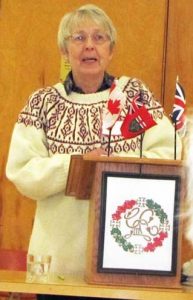 After a delightful potluck lunch, we held a brief business meeting and then had the pleasure of hearing Dr. Jane Errington, professor of history at the Royal Military College of Canada and Queen’s University.
After a delightful potluck lunch, we held a brief business meeting and then had the pleasure of hearing Dr. Jane Errington, professor of history at the Royal Military College of Canada and Queen’s University.
Jane’s title was “Coping with the Wilderness: Telling Women’s Stories of Early Upper Canada”. She explained that women with money, such as Elizabeth Simcoe (wife of the first Lt.-Gov. of Upper Canada, John Graves Simcoe) conveyed through diaries and letters home to family in England that life in Upper Canada was busy and interesting: not greatly different than life had been at home in England. However, others found the experience of coming to a new colony difficult and lonely. Margaret Ryerse came as a Loyalist, and her daughter Amelia Harris left letters and other documents describing Margaret’s life: no close neighbours, and dealing with the need to adapt to a new environment while sttempting to recreate parts of her old life such as family “entertainments”.
Frances Stewart, who arrived from Ireland in 1822, wrote letters home in which she admitted her excitement at the prospect of a new country was mixed with apprehension. She was a “gentlewoman” who settled near Rice Lake and raised ten children in a log house. Her letters home told how she still made time each day to read, to keep her mind stimulated. Her family was well-enough off that after five years in the wilderness her cousin could send her a piano!
Frances Stewart was helped by servants, but Dr. Etherington quoted from another Irish woman, Fanny Hutton, who bought a farm near Belleville in 1834. She also wrote letters describing her life with her five children. and a rather feckless husband: she was just barely getting by.
Both Frances and Fanny Jane lived in the country; Jane recommended Anna Jameson’s Winter Studies and Summer Rambles in Canada (published 1838; reprinted 1990, New Canadian Library) as an example of the life of an urban woman of the time.
Many letters and diaries of early settlers may be found at the Archives of Ontario.
